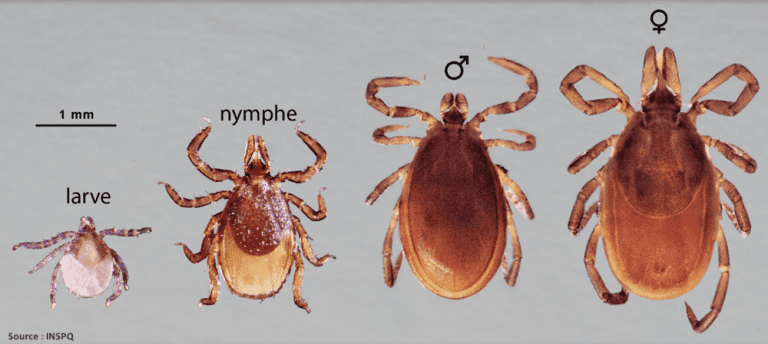When the weather’s nice, it’s crucial to keep in mind the risks associated with tick bites. Our Eco-Technician is here to support you with essential information and prevention tips to protect you and your family from the dangers these parasites can represent.
What are ticks and why should I care?
Ticks are small parasitic mites found in wooded areas, parks and green spaces. They can attach themselves to human or animal skin to feed on blood. In Quebec, 12 species of tick have been identified. The most dangerous is the black-legged tick, also known as Ixodes scapularis. It can transmit the Borrelia burgdorferi bacteria responsible for Lyme disease, which can have serious health consequences.
What's the tick situation in Quebec?
In Quebec, monitoring the tick population, particularly the blacklegged tick, is a priority. The effects of climate change (milder winters and warmer summers) have favored their proliferation and adaptation to new habitats. This has led to a significant increase in the risk of tick bites and associated diseases in the region.
In 2021, the assessment of at-risk areas revealed a significant expansion of areas classified as orange, signalling an increased level of threat. For the first time, even the island of Montreal is concerned, with the West Island now listed among the regions presenting a “significant risk” according to the Institut national de santé publique du Québec.
How to protect yourself against tick bites?
- Outdoor activities
When you’re out and about, make sure you stay on the trails and avoid the tall grass where ticks can be found. If you’re planning to go off-trail, follow these tips to avoid tick bites: wear long, light-colored clothing to make ticks easier to spot, as well as closed shoes and a hat. Tuck the bottom of your pants into your socks or boots. Using tick repellent can also help.
When you get home, check yourself and your children carefully for ticks. They can attach themselves anywhere, but they tend to lodge in warm, damp areas, as well as skin folds and areas where clothing is tight. Ticks can attach themselves to the skin for several hours or days before being detected. Essential areas to check are: around the waist, behind the knees, between the fingers and toes, in the armpits, navel and around the neck, as well as at the hairline.
Also check your equipment and pets to avoid introducing ticks into your home.
- In my garden
To reduce the presence of ticks in your environment, keep your garden tidy by cutting tall grass and removing dead leaves.
What to do in the event of a bite?
In the event of a bite, remove the tick as soon as possible. Use sterilized fine-tipped tweezers or a specially designed kit available from your chemist. Gently grasp the head of the tick close to the skin with the tweezers and pull firmly, taking care not to crush the insect’s abdomen, as this increases the risk of transmitting the bacteria responsible for Lyme disease.
After removal, carefully clean and disinfect the bite area. Store the tick in a plastic bag or empty pill container. Indicate the part of the body that was bitten and the date the tick was removed, and store it in the refrigerator. The tick may be useful if you need to see a doctor.
What to do in case of symptoms?
If you experience symptoms such as fatigue, fever, aches and pains or redness of the skin, call Info-Santé 811 or consult a doctor and provide details of the bite. In some specific areas, a preventive antibiotic may be recommended after consultation with a health professional.
What should I do if my pet has been bitten?
For advice on ticks on pets, consult the Lyme disease in animals webpage.
Other useful links
Quebec Government – Protect yourself and your animals from mosquito and tick bites
Institut national de santé publique du Québec – Maladie de Lyme : Analyse des tiques
Ministère de la santé et des services sociaux – Description de la maladie de Lyme
Santé Montérégie Portal – Modifying Your Landscape – Lyme Disease
Contact the Green Line
By phone: 514-684-3114
By e-mail: LigneVerte@ddo.qc.ca



